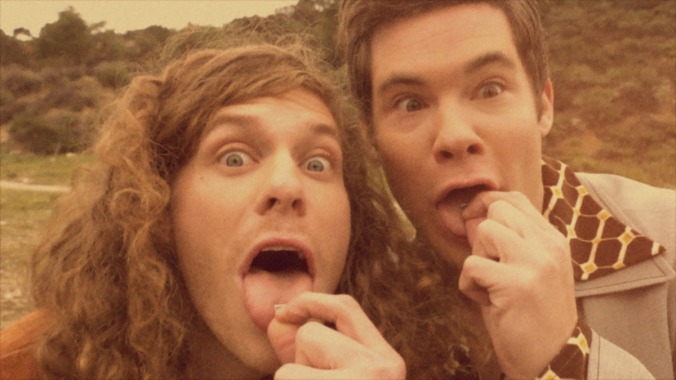We’ve all heard a comedian describe something funny that happened while they were high. It’s a staple of stand-up sets and house party court-holdings: They took some friendly fungi or a smiley-faced tab, didn’t feel anything after a half hour, took a bit more, and blasted right off. But the melting carpets, demonic mirror apparitions, and other hallucinatory amusements lose something in the telling: Like listening to someone recount a dream, these anecdotes primarily give the impression that you had to be there (and in that state of mind) to get it.
A longtime veteran of TV sitcoms (working at both David Letterman’s Late Night and Late Show, he advanced to The Simpsons, New Girl, Parks And Recreation, and Silicon Valley), Cary utilized what must be an extensive Rolodex to gather an array of talent. Nick Kroll recalls a beach bug-out that culminated with him morphing into Sigmund The Sea Monster, Rosie Perez melts into her mattress and wrestles with her Christian faith, and A$AP Rocky regales us with the time he ejaculated a neon rainbow that sounded like a piano glissando. The best bits come from the unexpected faces, however, as both Carrie Fisher and Anthony Bourdain return from beyond the veil to extol the upsides of mind-altering substances.
If this film can be said to have any purpose higher than a good trip, it would be to promote the validity and legitimacy of psychedelic drugs as aids to personal wellness. We get the usual Californian rhapsodizing about oneness with the Earth and harmony with nature, paired with less bleary-eyed commentary on mental and holistic health benefits. But while seeing bona fide household names (who doesn’t love Ben Stiller?) speak candidly about drug use does a lot to demystify what are somehow still classified as Schedule I narcotics, Cary’s not making a message doc, and his vague passes at scientific rigor play as perfunctory.
Cary instead steers his project back toward the more comfortable realm of comedy, where his famous friends can enliven the footage for him. Taking cues from Drunk History, he stages re-enactments to break up the action—although bringing in Workaholics’ Adam DeVine and Blake Anderson as stand-ins for Bourdain and a pal feels like subtraction by addition. Throughout the film, Adam Scott whisks us away to a faux-’80s after-school special in which Riki Lindhome, Maya Erskine, Ron Funches, and Haley Joel Osment learn some tough lessons the Reefer Madness way—segments that will be catnip to sketch nerds, the sort of people who’ll see the joke in Paul Scheer and Rob Corddry portraying each other, complete with corresponding fake teeth.
The most that everyone else can hope to get out of all this is an uncommonly levelheaded view of what drugs do. The participants certainly play up the fun side of LSD, mushrooms, and their many cousins, but enough of them also detail nightmarish detours into surreal hellscapes to convey how subjective these experiences can be. Across the board, Cary’s roster advocates for open availability of psychedelics to anyone who believes tripping out will enrich their life, without suggesting that head-expansion should be foisted on everybody as a one-size-fits-all cure for squareness. Its ambitions are humble in their chillness: Get totally zonked, if that’s your thing.
That being said, “ambitions” really have no place in discussions of a work that’s based around shooting the shit. In that, Cary’s found an ideal home for Have A Good Trip at Netflix, a platform that’s made passive, low-engagement viewing part of its business model. In this context, “passive” and “low engagement” are both discreet ways of saying that the film’s babbling tangents and candy-colored animated interludes pair well with cannabis—a quality that some watchers consider a negative. Those who don’t know who they are, and this film understands that they’re not always the tie-dye-and-Birkenstocks set that leap to mind when visualizing acidheads. Celebrities: They’re just like us!









































